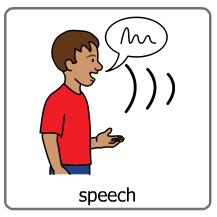* Note to fellow SLPs: There is a free printable parent handout at the bottom of this post describing the difference between speech and language…made by yours truly!
What is Speech?
- Articulation: the ability to coordinate your vocal folds, tongue, teeth, lips, jaw and palate to produce the speech sounds that are in their language. Some sounds are easier to learn than others and children will learn certain sounds later than other sounds. For example, a three year old child will be able to say ‘puppy’ correctly but might pronounce ‘rabbit’ as ‘wabbit’ because they haven’t learned how to produce an ‘r’ yet.
- Voice: the act of passing air from the lungs, through your vocal folds, to produce sound.
- Fluency: the rhythm and fluidity of speech. Fluency can be affected by hesitations or a stutter.
* A speech disorder or delay describes difficulties in any one of the above areas.
Examples of speech disorders:
- an 7 year old girl who consistently replaces the sounds ‘k’ and ‘g’ in her speech with ‘t’ and d’ (a process known as fronting)
- a teacher with a chronically hoarse voice due to overuse of her vocal folds
- a child who stutters
What is Language?
Language is a symbolic system made up of socially shared rules. In English, these symbols include written and spoken words, and also gestures. People who speak the language English can understand the meaning of ‘hello,’ use the word in appropriate situations (greeting people) and also share the knowledge that a wave can also mean ‘hello.’ Other commonly known gestures are shrugging your shoulder for ‘I don’t know,’ and holding up a finger to your mouth to say ‘be quiet.’
Language does not always have to include spoken words. For example, American Sign Language consists only of signs, and is governed by a completely different set of rules than English is.
The American Speech-Language-Hearing Association describes the rules of language to include the following:
Now that you know what the components of speech and language are and the potential difficulties that children may have within these areas, you can gain an understanding of what a Speech and Language Pathologist (SLP) does.

- “What words mean (e.g., “star” can refer to a bright object in the night sky or a celebrity
- How to make new words (e.g., friend, friendly, unfriendly)
- How to put words together (e.g., “Peg walked to the new store” rather than “Peg walk store new”)
- What word combinations are best in what situations (“Would you mind moving your foot?” could quickly change to “Get off my foot, please!” if the first request did not produce results)”
* A language disorder or delay can include difficulties in any one of the above areas
Speech and Language Pathology
Now that you know what the components of speech and language are and the potential difficulties that children may have within these areas, you can gain an understanding of what a Speech and Language Pathologist (SLP) does.
As an SLP, I work with a variety of children, some with speech impairments, some with language impairments and some with both. It is my job to provide these children with strategies and skills to help them overcome their difficulties.
For children who have severe speech and language impairments, communication is always the first goal. Communication does not require speech or language, just the ability to convey a message or meaning and share an understanding with another.
For example, when we are trying to communicate with someone who doesn’t speak the same language as us, we may use gestures, or draw a picture to get our message across.
It is the job of a SLP to give children with severe impairments in speech and language, a way to communicate their needs and their thoughts. This may be through signs, pictures, or electronic devices. This is known as Alternative and Augmentative Communication (AAC). Once we’ve given a child a way to communicate, we can then focus on increasing their skills in speech and/or language.
An example of the picture symbols that some children may use to communicate what they want.
That’s all for now folks! Hope that you learned something new today and that you have a better idea about what it is that I do 🙂
Below is a free handout that SLPs can print and share with parents.

Click here to access the free handout
Speech & Language Pathology – What IS it!?




